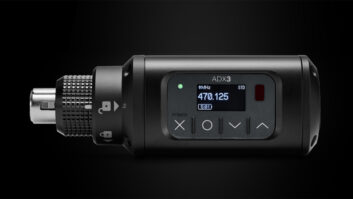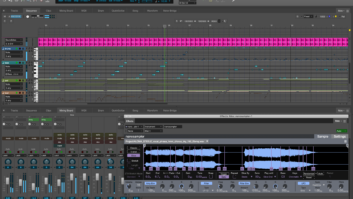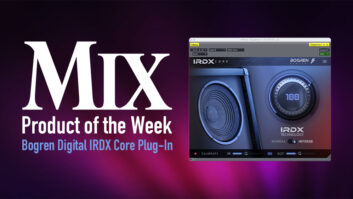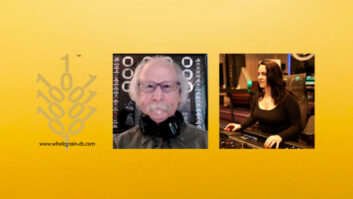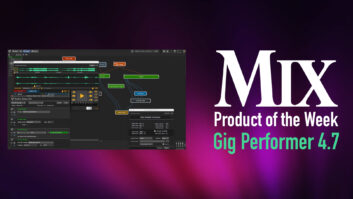
MOTU’s proprietary MAS plug-in Trigger is a handy tool to layer orreplace acoustic drum tracks with drum samples in Digital Performer(DP). Trigger converts audio pulses, such as kick drum hits, into MIDINote-On messages that can be routed to a sampler (or any other MIDIdevice). Using Trigger with virtual instruments such as BitHeadz UnitySession and Native Instruments Kon-takt, you won’t even have to leavethe digital domain in pursuit of the big bang.

You’ll need to open Kontakt and load an instrument (ormulti-instrument) into the program’s rack before you can trigger anyKontakt samples in DP; Unity Session does not need to be open in orderfor DP to find and trigger its samples.
Let’s examine the basic setup to trigger samples and record them toa new audio track. First, instantiate Trigger on a mixer insert for theaudio track (e.g., kick drum) that you wish to layer or replace withsamples. Record-enable a new MIDI track and choose Trigger as its inputand your virtual instrument as its output. If your virtual instrumentoffers presets (as Unity Session does), then choose a suitable one inthe Default Patch column of your record-enabled MIDI track. Kontaktdoes not offer presets because it is purely a sampler; the (multi-)instrument currently in Kontakt’s rack will automatically receive inputwhen Kontakt is chosen as an output destination for your record-enabledMIDI track.
Now, select your virtual instrument’s output(s) as the input sourcefor a new audio track and make that track record-ready. With DP’sinput-monitoring mode set to monitor source signals and MIDI Patch Thruenabled, put DP into Play mode. As you begin to adjust Trigger’sparameters to suitable values, you should hear drum samples triggeredin your virtual instrument.
TRIGGER TREAT
Use Trigger’s MIDI note control to select the MIDI note that youwant to generate with each trigger pulse. For example, choose C1 togenerate a kick drum sound in GM-compatible MIDI instruments. Then, setTrigger’s threshold control high enough so that only deliberate drumhits produce a MIDI Note-On message and mic bleed and other extraneousnoises get weeded out. The length of the generated MIDI note can be setwith Trigger’s duration control.
Dialing in a retrigger delay time of approximately 200 ms willusually eliminate double strikes caused by, for example, a sloppydrummer’s kick drum beater bouncing off of the drum’s head a secondtime. If that doesn’t do the trick, try inserting a gate plug-in beforeTrigger and gating the bejeezus out of the audio track so that only avery short attack gets through. (If you need to preserve the originaltrack in the mix, then duplicate it and apply this technique to theduplicate and mute Trigger’s output as explained later in thisarticle.) The errant second strike is usually lower in level than theintended hit, making it relatively easy to eliminate with the gate.MOTU’s MasterWorks Gate usually performs this task well.
If you’d like to layer the original track with the triggeredsample, then you’ll want to preserve its entire envelope (subject tocreative whims). In this case, make a copy of the original track, gatethe copy and send the processed result on to Trigger (via an insert, asdetailed above). You might not want to hear the short blip of gatedaudio that’s used to feed Trigger. To mute the blip, click on the blackbutton above Trigger’s numeric threshold readout so that the virtualred LED to the right of the button lights up. Doing so mutes the audiotrack’s output while preserving its signal feed to Trigger.
When replacing drum tracks with samples, I usually mute Trigger’saudio input early on in the process so that I can more effectivelyaudition prospective replacement samples. But once I’ve chosen thesound I want, I’ll temporarily turn off Trigger’s Mute button while I’mtweaking the plug-in’s parameters. I’ll pan the original drum track abit to one side of the stereo spectrum and the triggered sample to theother side so I can hear both sounds more discretely. I’ll then listenfor dropped Note-Ons, double triggers and/or latency.
To reduce latency, move Trigger’s horizontal slider labeled“faster trigger/more accurate velocities” to the left.Unfortunately, as you increase Trigger’s reaction time, the velocitiesof the generated MIDI Note-Ons track the dynamics of the plug-in’saudio input less accurately. And even with the fastest trigger timeset, you’re still likely to have unacceptable latency. The solution, ofcourse, is to nudge the recorded drum sample’s track forward (earlier)in time to align it with the original audio track.
One last point: If you’re replacing (rather than layering)well-isolated trap-drum tracks with triggered samples and the drummer’soriginal performance wasn’t in the groove, then apply some moderatequantization to the recorded MIDI track that was generated by Trigger.Make sure the quantized track is routed to your soft sampler, and routeyour soft sampler’s output to an aux track in DP to listen to thetidied-up results. Once the drum track is groovin’ to your liking,record your soft sampler’s triggered output to a blank audio track.
Mix contributing editor Michael Cooper owns Michael CooperRecording in beautiful Sisters, Ore.

This tip was excerpted from the June “Cool Tip of theMonth” pages from our sister magazine, Electronic Musician. Formore of this month’s great tips, visit
http://emusician.com/ar/emusic_cool_tip_month_10.Tracking with Plug-InsYou need to lay down a bass part, and you would like to use aplug-in to compress the track. Do you realize that when you record atrack in most digital audio workstation software, the plug-in insertsare post — hard disk? For example, if you create a track in MOTUDigital Performer 3 (DP3) and insert a compressor, you are notcompressing to hard disk when you record. When you listen back, theunaffected bass part streams from the hard drive and through theplug-in on its way to your audio interface.If you’re familiar with analog mixing consoles, it’s like insertinga compressor in the monitor section versus the input section. Theadvantage is that you can edit the plug-in parameters later. Awork-around is available, however, and with a sufficiently powerfulcomputer and the right settings, latency isn’t an issue.1. First, in order to minimize monitor latency,adjust the Samples Per Buffer in DP3’s Configure Hardware Driverswindow from the default of 1,024 to 256 (or lower if possible). Thelowest value that you can set will depend on what your hardwareconfiguration is.2. Next, open the Mixing Board from the Windowsmenu (Shift + M). Add an aux track (Control + Command + A), an audiotrack (Shift + Command + A), and a master track (Control + Command + M)from the Mixing Board’s mini-menu.3. Insert a compressor plug-in on the aux track.Configure its input to the hardware input that your bass is pluggedinto, and set the output to bus 1.4. On the audio track, set the input to bus 1 andthe output to out 1-2, and then arm the track.5. Adjust the compressor to your taste and record abass part.In this configuration, the bass part is first being compressed andthen routed to the mono track and recorded. Some lesser systems mayexperience latency, but with newer, faster computers, that will be lessof an issue.— Steve AlbaneseTake a tour of Digital Performer on MOTU’s Web site.


